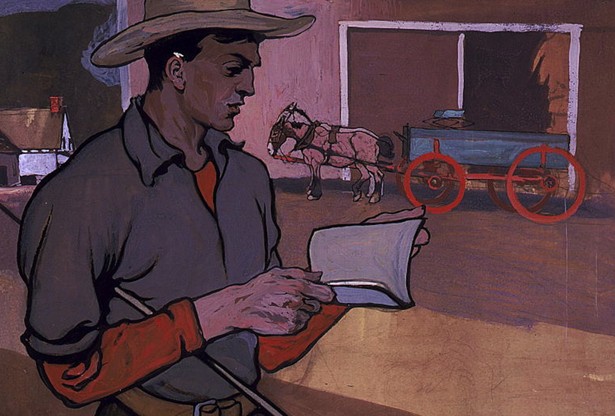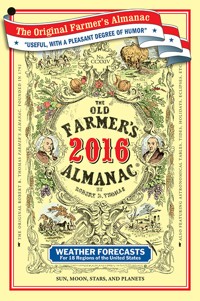Clik here to view.

Before the Internet—and I mean long, long, long before the Internet—an almanac was a radical, high-tech object.
It must have seemed, to the people of the 1792, when The Farmer’s Almanac was founded, something like what a smartphone is to people today: a handheld, portable device that contained information about all manner of things—health advice, weather predictions, jokes, recipes, charts detailing the times of sunrises and sunsets, and other “new, useful, and entertaining” tidbits, as the cover promised.
The Farmer’s Almanac—“old” wouldn't be added to its name until sometime in the early 1800s—joined a crowded market of similar almanacs at a time when the format offered an unprecedented kind of access to information, folklore, and reference material. Ben Franklin has been on the cover of The Old Farmer’s Almanac for generations, a nod to Franklin’s publication, Poor Richard's Almanack, which came first. There are still other farmer’s almanacs in print, like Harris’ Farmer’s Almanac, for example. But The Old Farmer’s Almanac bills itself as the original by today’s standards—and the oldest continuously published periodical in the United States. When the first issue came out, George Washington was president.
“What most people had in their homes for reading material at the time was a Farmer’s Almanac and a Bible," said Janice Stillman, who has been the editor of The Old Farmer’s Almanac since 2000, “And only one of those took ads, by the way.”
The publication’s popularity in its youth is perhaps unsurprising, even in a crowded market for almanacs. What’s more remarkable is that The Old Farmer’s Almanac has stayed in print for more than two centuries. “The values are, you might say, old,” Stillman told me, “but they’re also timeless.”
Timeless, and still meticulously concerned with the particularities of time’s passages—including the positions of planets and other celestial bodies, the movement of the tides, and, of course, the weather. The Old Farmer’s Almanac is famous for its long-term forecasting. And this reputation has remained intact, even as the cultural space weather occupies, and the technology used to track the weather, has dramatically changed.
The founder of The Old Farmer’s Almanac, Robert B. Thomas, used a forecasting technique based on a theory that Galileo developed in the 17th century. “The idea that sunspots, on cycles of 11 years on average, influenced the climate and weather on Earth,” Stillman told me. “Robert B. Thomas made his forecast based on that.”
The Almanac still incorporates sunspot data into its forecasting model today. “There are patterns that suggest that when the sun is quiet, the weather on earth is cooler than usual,” Stillman said. Modern science hasn’t ruled out this connection.
Clik here to view.

That said there are now much more precise ways to predict the weather accurately. In the past two decades, the advances in forecasting technology have been “tremendous,” said Christopher Vaccaro, a spokesman for the National Weather Service.
“We’ve seen a massive improvement in forecasting,” Vaccaro told me. “You look at radar screens pre-1970 and you would just see a big blob, but now we have radar that picks up discrete thunderstorm cells, ash plumes, flocks of birds.”
Forecasting models, more accurate than ever before, now come from trillions of pieces of data processed by supercomputers. Satellites and a network of sophisticated weather balloons, along with high-tech radar, help complete the picture. “You need to take the pulse of the planet as it is now,” Vaccaro said. “And then once you know where you are, you are able to project where you’re going.”
Today, five-day forecasts are as accurate as two-day forecasts were 20 years ago. “The forecasts are not only becoming more accurate but they’re also becoming more accurate further in time,” Vaccaro said.
The Old Farmer’s Almanac has long had a reputation for getting the forecast right, and doing so on an outlandish timescale. In the 1930s and 1940s, people would write to the Almanac to ask about weather conditions for specific days, months in advance. Brides wanted sunshine for their wedding days; rabbis would ask for the exact time of sunset in a certain city, so they could plan the lighting of altar candles. The Almanac was known then, as it is now, for being “New Englandish as a stone wall... [and] just as durable,” wrote The New York Times in a 1947 feature about then-editor Robb Sagendorph.
“A society woman in a New York Suburb wants to give a lawn party on a Saturday in June,” the Times wrote. “Mr. Sagendorph, at her behest, studies his weather records of the years and recommends the third Saturday. Sure enough, the first and second Saturdays turn out rainy in the Hudson Valley, and the third is clear.” (Sagendorph apparently embraced some degree of irreverence about his publication’s reputation for weather-related omniscience. “The best time of the moon to catch fish,” he deadpanned to the Times, “is when the fish are biting.”)
But people still turn to the Almanac for an idea of what the year to come will be like, not unlike the way they look to the groundhog to find out how long winter will last. “There have been many, many different kinds of weather prophets and people who thought they had it wired for predicting the weather,” said Paul Edwards, a professor of information and history at the University of Michigan. “They were sometimes right, which is why these phenomenon persist.” (In addition to tracking sunspots, the Almanac also incorporates “all the latest satellite data, ocean temp[erature] records, jet-stream patterns,” and other modern information in its forecasting model today, Stillman told me.)
“But it’s not that hard to be right some of the time about the weather, even just by guessing,” Edwards said. “The sunspots and stuff like that, space weather, just don’t have much effect... I would just put it in a category of folk knowledge about weather that is sometimes really useful but, in terms of details, it has never been as good as it claims to be.”
But The Old Farmer’s Almanac didn’t have to be right all the time, it just had to be right most of the time. The perception that it was is a big part of why the Almanac has endured. (The fact that predictions aren’t too specific probably helps, too.) “The Farmer’s Almanac was originally for farmers, when most people were farmers,” Edwards said. “Predicting the weather for a farmer was a matter of life or death.”
Discussing the weather was also, and remains, a deeply rooted part of culture. That’s in part because of how important conditions were, and still are, to farming—but also because the weather conditions inform so many other aspects of life. “What people do, what sports they like, what kinds of crops they can raise, what they can eat, the clothes they wear,” Edwards said. “There’s a tight interconnection between our climates and our cultures. I think one of the sad things about urban civilization as we know it is we’ve become more disconnected from that. Many people spend most of their time in climate-controlled environments.”
And yet people remain obsessed with the weather. It’s the go-to subject matter for small talk: a shared experience that’s easy to observe and inoffensive to describe. There are dozens of smartphone apps dedicated to forecasting, storm tracking, radar, and severe weather. The National Oceanic and Atmospheric Administration’s app is among the most popular paid apps for the iPhone.
There are other apps that mirror the kind of content that appeared in The Old Farmer’s Almanac from the very beginning, like GPS data, for example. Satellites didn’t exist in 1792, but the Almanac did publish the distances between popular destinations. A sort of Google maps of the era.
Actually, the hodge-podge of material in The Old Farmer’s Almanac, when considered in 2015, is downright Internetty. (In addition to publishing 3 million print copies each year, the Almanac has a website and a Facebook page with more than 1 million fans.) “Today, we think of an almanac as quaint, but back then it was really high-tech, like a hand-held computer,” Tim Clark, an executive editor, told TheNew Yorker in 1988. “The almanac is a characteristic of the late eighteenth century, the Age of Enlightenment. The universe as machine: Once you get the operating instructions, you can tell the future.”
“Like the Internet itself, the Almanac has always been a happy grab bag of marginalia,” wrote Jeff MacGregor for The New York Times in 1997.
That mélange includes the sort of home remedies that are just crazy-sounding enough to be, if not effective, plenty distracting from the problem at hand. (“It has to be true—or, rather, not made up,” Clark said. “It may be wrong, but the point is somebody believed it once.”)
For example, if you have arthritis: “Pack a small jar with golden raisins and cover them with gin. Eat nine raisins every morning, squeezing the extra gin back in the jar.” For brittle nails: “Eat Jell-O. Or you can mix your favorite flavor of Jell-O and drink it while it's still warm, if you don't feel like waiting to refrigerate it.” To prevent a cold: “Boil a whole onion, and afterward, drink the water.”
And, more broadly, to avoid dying: Absolutely no haircuts in March, don't sing in bed, don't cook your own birthday dinner, never serve 13 at a table, don't walk backwards, never count the cars on a passenger train, don’t let two people comb your hair at once, and don't walk around in one shoe.
“Both [the Internet and the Almanac] bear the current predictions for our common future,” MacGregor wrote. “Only one puts the weight of memory back in your hand.”
Occupying that space, somewhere between remembering and predicting, is what makes The Old Farmer’s Almanac unusual. Stillman repeatedly referred to the publication as “a time capsule of the year.” The curious thing is: Most time capsules are about things that have already happened, not the ones that are about to happen.
“Keep in mind that the brand is old but the publication is absolutely new from white paper every year,” Stillman said. “It’s old, but it’s not old-fashioned.”
Image may be NSFW.Clik here to view.